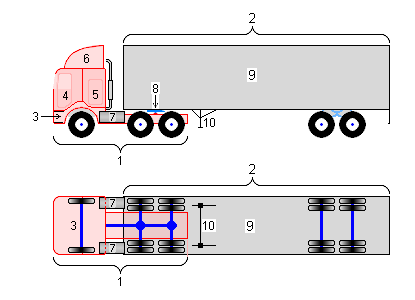
P2630 B2S2 O1 Sensor Pumping Current Correction Circuit Low
Content
P2630 B2S2 O1 Sensor Pumping Current Correction Circuit Low
OBD-II DTC Datasheet
O2 Sensor Pump Current Limiting Circuit Bank 2 Sensor 1 Low
What does this mean?
This Generic Powertrain Diagnostic Trouble Code (DTC) typically applies to all OBD-II equipped vehicles, including but not limited to Ford, Kia, Hyundai, Mini, Audi, VW, Mercedes, BMW, etc.
DTC P2630 OBDII is associated with the O2 sensor pump current control circuit. Six different codes can be set for the first sensor, known as the upstream sensor, when the powertrain control module (PCM) detects a malfunction in the O2 sensor pump current control circuit.
These are codes P2626, P2627, P2628, P2629, P2630 and P2631 based on a specific signal that alerts the PCM to set the code and turn on the Check Engine light.
Code P2630 is set by the PCM when the O2 sensor pump current control circuit for bank 2 sensor 1 sends a lower voltage signal than normal. Bank 2 is an engine group that does not contain cylinder #1.
What does an O2 sensor do?
The O2 sensor is designed to monitor the amount of unburned oxygen in the exhaust gas as it leaves the engine. The PCM uses signals from the O2 sensors to determine the oxygen level in the exhaust gas.
These readings are used to monitor the fuel mixture. The PCM will adjust the fuel mixture accordingly when the engine is on rich (less oxygen) or lean (more oxygen). All OBDII vehicles have at least two O2 sensors, one in front of the catalytic converter (in front of it) and one after it (downstream).
The independent dual exhaust configuration will include four O2 sensors. This P2630 code is associated with sensors upstream of the catalytic converter (sensor # 1).
Code severity and symptoms
The severity of this code is moderate, but will progress if not corrected in a timely manner. Symptoms of a P2630 trouble code may include:
- Poor performance that progresses
- The engine will run on a lean mixture
- The engine will run at full power.
- Check Engine light is on
- Exhaust smoke
- Increased fuel consumption
Common Causes of the P2630 Code
Possible reasons for this code could include:
- Defective O2 sensor
- Carbon build-up on O2 sensor
- Blown fuse (if applicable)
- Fuel pressure too high
- Fuel pressure too low
- Vacuum leak in the engine
- Excessive exhaust gas leak
- Corroded or damaged connector
- Faulty or damaged wiring
- Defective PCM
P2630 Diagnostic and Repair Procedures
Check for TSB availability
The first step in troubleshooting any problem is to review the vehicle-specific Technical Service Bulletins (TSBs) by year, model, and powerplant. In some cases, this can save you a lot of time in the long run by pointing you in the right direction.
The second step is to install an O2 sensor upstream of the catalytic converter. Perform a thorough visual inspection to check the associated wiring for obvious defects such as scratches, abrasions, exposed wires, or burn marks. Next, you should check the connector for security, corrosion and damage to the contacts. With the engine running, visual inspection should include the identification of possible exhaust leaks. Fuel pressure testing may be recommended depending on fuel consumption and engine performance. You should consult specific technical data to determine this requirement.
Advanced steps
The additional steps become very vehicle specific and require appropriate advanced equipment to be performed accurately. These procedures require a digital multimeter and vehicle-specific technical reference documents. Voltage requirements depend on the specific year of manufacture, vehicle model and engine.
Voltage test
When the fuel mixture is balanced at about 14.7 to 1, which is normal for most engines for optimum performance, the gauge will read about 0.45 volts. An oxygen sensor typically generates up to about 0.9 volts when the fuel mixture is rich and unburned oxygen is present in the exhaust. When the mixture is lean, the sensor output will drop to about 0.1 volts.
If this process detects that there is no power source or ground connection, a continuity test may be required to verify the integrity of the wiring. Continuity testing should always be performed with power removed from the circuit, and a normal reading should be 0 ohms of resistance unless otherwise specified in the datasheet. Resistance or no continuity indicates that a faulty wiring is open or shorted and needs to be repaired or replaced.
Normal repair
- Replacing or cleaning the O2 sensor
- Replacing a blown fuse (if applicable)
- Fuel pressure adjustment
- Eliminating engine vacuum leaks
- Elimination of exhaust leaks
- Cleaning connectors from corrosion
- Repair or replacement of wiring
- Flashing or replacing PCM
Hopefully the information in this article has helped point you in the right direction for solving your O2 sensor pump current trim loop problem. This article is for informational purposes only and specific technical data and service bulletins for your vehicle should always take priority.
Related DTC discussions
- Ford Taurus P2630Obd p2630…
Need more help with the P2630 code?
If you still need help with DTC P2630, post a question in the comments below this article.
NOTE. This information is provided for informational purposes only. It is not intended to be used as a repair recommendation and we are not responsible for any action you take on any vehicle. All information on this site is protected by copyright.

